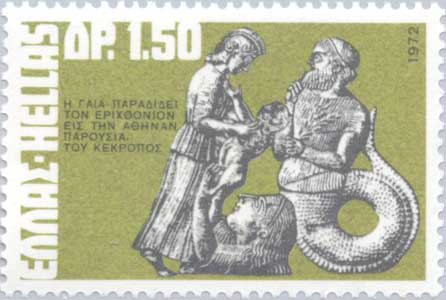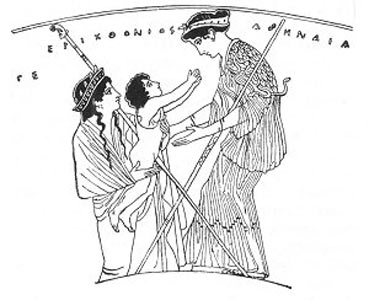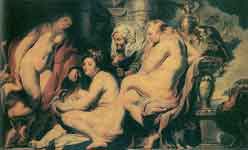.

Gaea (or Gaia) gives Erichthonius to Athena in the presence of Kekrops (or Cecrops), Terracotta now in Berlin
King Erichthonius (also called Erechtheus I or Erichthonios) was, according to some legends, autochthonous (born of the soil), and in other accounts he was the son of Hephaestus and Gaia or Athena or Atthis. According to Apollodorus, Hephaestus attempted to rape Athena but was unsuccesful. His semen fell on the ground, impregnating Gaia. Gaia didn't want the infant Erichthonius, so she gave the baby to Athena. Athena gave three sisters, Herse, Pandrosus and Aglaulus a small box and warned them to never open it. Aglaulus and Herse opened the box which contained the infant and future-king, Erichthonius ("troubles born from the earth"). The sight caused Herse and Aglaulus to go insane and they threw themselves off the Acropolis. Alternatively, Athena raised Erichthonius herself.
The Discovery of the Child Erichthonius, Peter Paul Rubens
P. Rubens The daughters of Cecrops finding the infant Erichthonius of Athens, 1616
An alternative version of the same story is that, while Athena was gone bringing a mountain from Pallene to use in the Acropolis, the sisters, minus Pandrosus again, opened the box. A crow witnessed the opening and flew away to tell Athena, who fell into a rage and dropped the mountain (now Mt. Lykabettos). Once again, Herse and Aglaulus went insane and threw themselves to their deaths off a cliff.
Erichthonius later became King of Athens and implemented many beneficial changes to Athenian culture. During this time, Athena frequently protected him. He founded the Panathenaic Festival in the honor of Athena. He taught his people to yoke horses and use them to pull chariots, smelt silver and till the earth with a plough.
Erichthonius was killed by either Poseidon or Zeus as revenge for killing Himmarados of Thrace during a war between Eleusis and Athens. He was succeeded by his son Pandion I. He was sometimes said to be a snake with a human head. The snake was his symbol.
Vase Paintings from Perseus:
Birth of Erichthonius
Athena and Erichthonius

Gaea (Ge), Erichthonius and Athena, drawing from a vase

Erichthonius Staatliche Antikensammlungen 2413

The daughters of Cecrops finding Erichthonius, 1617 Jacob Jordaens
The Daughters of Cecrops Finding Erichthonius, Jacob Jordaens
The daughters of Cecrops find Erichthonius, Hendrik Heerschop
Preceded by Amphictyon
Succeeded by Pandion I
See also : Greek Mythology. Paintings, Drawings
Greek Mythology Index
A - B - C - D - E - F - G - H - I - J - K - L - M -
N - O - P - Q - R - S - T - U - V - W - X - Y - Z
Α - Β - Γ - Δ - Ε - Ζ - Η - Θ - Ι - Κ - Λ - Μ -
Ν - Ξ - Ο - Π - Ρ - Σ - Τ - Υ - Φ - Χ - Ψ - Ω
| Ancient Greece
Science, Technology , Medicine , Warfare, , Biographies , Life , Cities/Places/Maps , Arts , Literature , Philosophy ,Olympics, Mythology , History , Images Medieval Greece / Byzantine Empire Science, Technology, Arts, , Warfare , Literature, Biographies, Icons, History Modern Greece Cities, Islands, Regions, Fauna/Flora ,Biographies , History , Warfare, Science/Technology, Literature, Music , Arts , Film/Actors , Sport , Fashion --- |
Retrieved from "http://en.wikipedia.org"
All text is available under the terms of the GNU Free Documentation License




